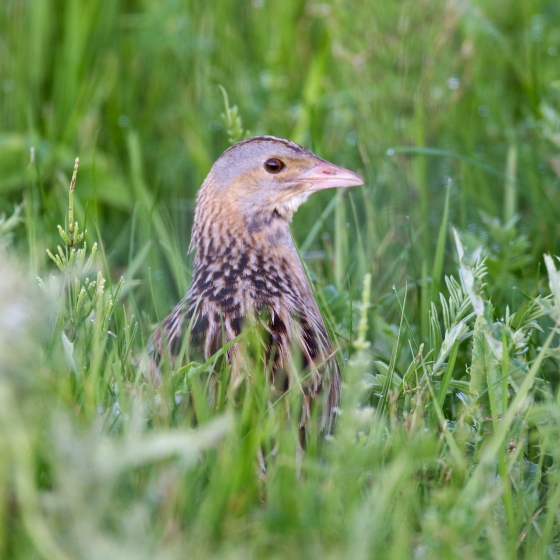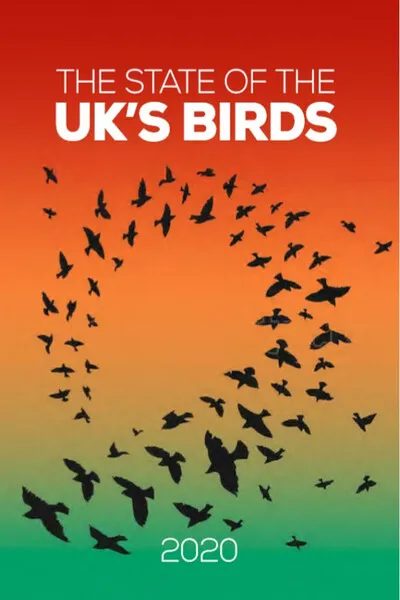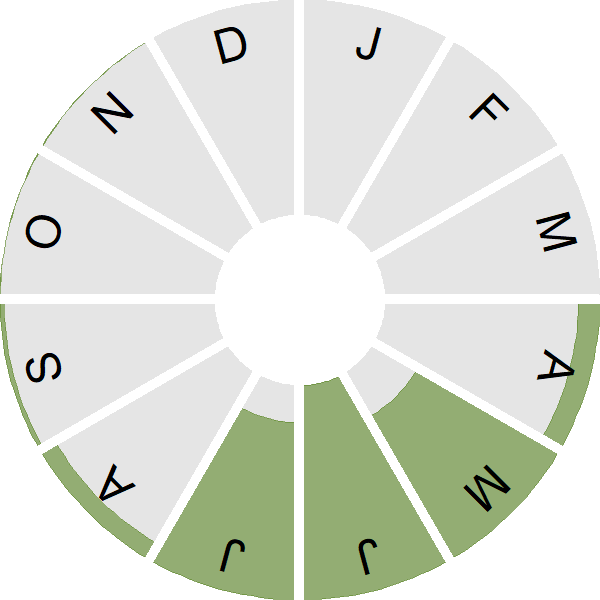Corncrake

Introduction
Now largely restricted to a small number of island and coastal strongholds in Scotland and Ireland, this migratory crake is a summer visitor to our shores.
Once a widespread and abundant species over much of Britain & Ireland, the Corncrake's decline is the result of changing agricultural practices, especially the more intensive management of the meadow habitats favoured by this species.
Attempts to reintroduce Corncrakes to former haunts in the eastern half of England are proving successful, though wider gains elsewhere are the result of initiatives to manage favoured habitats better.

Key Stats
Identification
Songs and Calls
Song:
Call:
Status and Trends
Conservation Status
Population Change
The Corncrake has decreased substantially since the middle of the 20th century when it was still a widespread breeding species. The species is monitored by the RBBP and subject to dedicated annual surveys by the RSPB. Numbers have increased strongly in the 25 years to 2019 but there has been a decline in the latter part of that period and the 904 singing males recorded in 2019 was the lowest number since 2003 (Eaton et al. 2021).
Distribution
Corncrakes have declined markedly since the 1970s and are now confined to a small number of coastal and island strongholds in Scotland and Ireland, with outlying populations in southern England the result of intense management and captive releases.
Occupied 10-km squares in UK
or view it on Bird Atlas Mapstore.
or view it on Bird Atlas Mapstore.
European Distribution Map
Distribution Change
Change in occupied 10-km squares in the UK
or view it on Bird Atlas Mapstore.
or view it on Bird Atlas Mapstore.
Seasonality
Corncrakes are summer visitors from April onwards, with records presumably declining as birds cease calling; a few records of passage birds in autumn.
Weekly pattern of occurrence
The graph shows when the species is present in the UK, with taller bars indicating a higher likelihood of encountering the species in appropriate regions and habitats.

Movement
Britain & Ireland movement
Foreign locations of birds ringed or recovered in Britain & Ireland
Dots show the foreign destinations of birds ringed in Britain & Ireland, and the origins of birds ringed overseas that were subsequently recaptured, resighted or found dead in Britain & Ireland. Dot colours indicate the time of year that the species was present at the location.
- Winter (Nov-Feb)
- Spring (Mar-Apr)
- Summer (May-Jul)
- Autumn (Aug-Oct)

European movements
EuroBirdPortal uses birdwatcher's records, such as those logged in BirdTrack to map the flows of birds as they arrive and depart Europe. See maps for this species here.
The Eurasian-African Migration Atlas shows movements of individual birds ringed or recovered in Europe. See maps for this species here.
Biology
Productivity and Nesting
Nesting timing
Egg measurements
Clutch Size
Survival and Longevity
Survival is shown as the proportion of birds surviving from one year to the next and is derived from bird ringing data. It can also be used to estimate how long birds typically live.
View number ringed each year in the Online Ringing Report.
lifespan
Survival of adults
Biometrics
Wing length and body weights are from live birds (source).
Ring Size
Classification, names and codes
Classification and Codes
- Order: Gruiformes
- Family: Rallidae
- Scientific name: Crex crex
- Authority: Linnaeus, 1758
- BTO 2-letter code: CE
- BTO 5-letter code: CORNC
- Euring code number: 4210
Alternate species names
- Catalan: guatlla maresa eurasiàtica
- Czech: chrástal polní
- Danish: Engsnarre
- Dutch: Kwartelkoning
- Estonian: rukkirääk
- Finnish: ruisrääkkä
- French: Râle des genêts
- Gaelic: Traon
- German: Wachtelkönig
- Hungarian: haris
- Icelandic: Engirella
- Irish: Traonach
- Italian: Re di quaglie
- Latvian: grieze
- Lithuanian: paprastoji griežle
- Norwegian: Åkerrikse
- Polish: derkacz (zwyczajny)
- Portuguese: codornizão
- Slovak: chrapkác polný
- Slovenian: kosec
- Spanish: Guión de codornices
- Swedish: kornknarr
- Welsh: Rhegen yr Yd
- English folkname(s): Hay Crake, Land Rail
Research
Causes of Change and Solutions
Causes of change
There is good evidence that the widespread declines during the 20th century were caused by agricultural intensification, in particular early and mechanised mowing of meadows (Green et al. 2009; see also review by Green, 2020). Intensive conservation efforts have sustained the population in its remaining strongholds on the Hebrides. Successful measures to maintain and increase the remaining Scottish island populations have resulted from the conservation measures implemented within agri-environment schemes, including the planting of early cover and the use of Corn Crake friendly mowing methods (O'Brien et al. 2006, Green 2020). However, slight declines since 2015 may have been caused by slight changes in the agri-environment scheme prescriptions which may have led to changes in mowing practices; further research is needed to confirm this and recommend solutions (Green 2020).
Publications (1)
The State of the UK's Birds 2020
Author: Burns, F., Eaton, M.A., Balmer, D.E., Banks, A., Caldow, R., Donelan, J.L., Douse, A., Duigan, C., Foster, S., Frost, T., Grice, P.V., Hall, C., Hanmer, H.J., Harris, S.J., Johnstone, I., Lindley, P., McCulloch, N., Noble, D.G., Risely, K., Robinson, R.A. & Wotton, S.
Published: 2020
The State of UK’s Birds reports have provided an periodic overview of the status of the UK’s breeding and non-breeding bird species in the UK and its Overseas Territories since 1999. This year’s report highlights the continuing poor fortunes of the UK’s woodland birds, and the huge efforts of BTO volunteers who collect data.
17.12.20
Reports State of Birds in the UK


